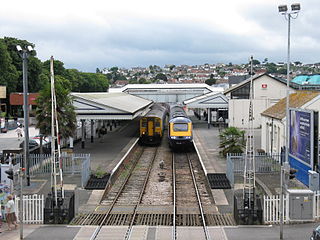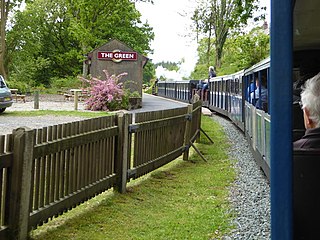
The Ravenglass and Eskdale Railway is a 15 in minimum gauge heritage railway in Cumbria, England. The 7-mile (11.3 km) line runs from Ravenglass to Dalegarth Station near Boot in the valley of Eskdale, in the Lake District. At Ravenglass the line ends at Ravenglass railway station on the Cumbrian Coast Line.

The Midland Railway – Butterley is a heritage railway and museum complex at Butterley, near Ripley in Derbyshire.

Teignmouth railway station is on the Exeter to Plymouth line and serves the seaside town of Teignmouth in Devon, England. It is located 208 miles 70 chains (336 km) from London Paddington, via Box. It is operated by Great Western Railway and is the third-busiest station on the Riviera Line after Exeter St Davids and Newton Abbot.

Ravenglass is a railway station on the Cumbrian Coast Line, which runs between Carlisle and Barrow-in-Furness. The station, situated 29+1⁄4 miles (47 km) north-west of Barrow-in-Furness, serves the village of Ravenglass in Cumbria. It is owned by Network Rail and managed by Northern Trains.

Bodmin Parkway railway station is on the Cornish Main Line that serves the nearby town of Bodmin and other parts of mid-Cornwall, England. It is situated 3 miles (4.8 km) south-east of the town of Bodmin in the civil parish of St Winnow, 274 miles 3 chains from London Paddington measured via Box and Plymouth Millbay. Network Rail’s National Rail Timetable dated May 2023 records the distance from London Paddington to Bodmin Parkway as 252.50 miles.

Paignton railway station serves the town and seaside resort of Paignton in Devon, England. It is 222 miles 12 chains (358 km) from London Paddington, via Box. It opened in 1859 and is now the terminus of Riviera Line services from Exeter and heritage services on the Dartmouth Steam Railway from Kingswear.

The Rudyard Lake Steam Railway is a ridable miniature railway and the third railway of any gauge to run along the side of Rudyard Lake in Staffordshire, England.

Douglas Railway Station is the main terminus of the Isle of Man Railway and is located at the landward end of the quay in Douglas, the capital of the Isle of Man. It was once the hub for now closed lines to Peel, Ramsey and Foxdale.

Minehead railway station is situated in Minehead, Somerset, England. First opened in 1874 as the terminus and headquarters of the Minehead Railway, it was closed by British Rail early in 1971. It reopened in 1976 and is now the terminus and headquarters of the West Somerset Railway, a heritage railway.

Albury railway station is a heritage-listed railway station at Railway Place, Albury, New South Wales, Australia, adjacent to the border with Victoria, in Australia. It was designed under the direction of John Whitton and built from 1880 to 1881. It was added to the New South Wales State Heritage Register in 1999.

Williton railway station in Williton, Somerset, England, was opened by the West Somerset Railway in 1862 and closed by British Rail in 1971. It was reopened in 1976 as a heritage line. The locomotive workshops here are the headquarters of the Diesel and Electric Preservation Group (DEPG).

Llanuwchllyn railway station in the village of Llanuwchllyn, Gwynedd, Wales, was formerly a station on the Ruabon to Barmouth line. It closed to passengers on Monday 18 January 1965 at the same time as the rest of the line, but subsequently reopened in 1972 as the southern terminus of the narrow gauge Bala Lake Railway. The station had a signal box and was a passing place on the single line.

The Devon and Somerset Railway (D&SR) was a cross-country line that connected Barnstaple in Devon, England, to the network of the Bristol and Exeter Railway (B&ER) near Taunton. It was opened in stages between 1871 and 1873 and closed in 1966. It served a mostly rural area although it carried some through services from east of Taunton to the seaside resort of Ilfracombe.

Irton Road railway station is a railway station on the 15 in gauge Ravenglass & Eskdale Railway in the Lake District National Park and the English county of Cumbria. The station is situated on the western edge of the village of Eskdale Green. It is some 4 miles (6.4 km) from Ravenglass and 3 miles (4.8 km) from Dalegarth for Boot, and trains take 20 minutes to reach their destinations in either direction from this station.

The Green is a railway station on the 15-inch gauge Ravenglass & Eskdale Railway in the Lake District National Park and the English county of Cumbria. The station is situated on the southern edge of the village of Eskdale Green, overlooking the Eskdale valley and Muncaster Fell. It was originally known as King of Prussia after the nearby public house, and later as Eskdale Green. The Eskdale Green name has continued in popular use, and was still in official use in 2017 in the railway's "full" timetable of intermediate stopping places.

Muncaster Mill railway station is a railway station on the 15 in gauge Ravenglass & Eskdale Railway in Cumbria, England. The station is located 1 mile (1.6 km) from Ravenglass and 6 miles (9.7 km) from Dalegarth, at the point where the A595 coast road crosses the line. It is situated on the bank of the River Mite and adjacent to Muncaster Mill, formerly a watermill but now a private house, from which it takes its name.

Dalegarth railway station is the easterly terminus of the 15-inch gauge Ravenglass and Eskdale Railway in the English county of Cumbria. It has a café and shop for passengers, along with a run-round loop, turntable and siding for trains.

Wansford railway station is the headquarters of the Nene Valley Railway in Cambridgeshire, England. The station building was opened in 1995 and contains a ticket office, shop, cafe and toilets. The locomotive sheds are located at this station. Also at the station there is a picnic area and children's playground. The station was formerly the junction for a branch to Stamford, which separated to the north just east of the river bridge at Wansford.

Barnstaple railway station was the western terminus of the Devon and Somerset Railway. It was situated on the south eastern side of Barnstaple in Devon, England. It was served by passenger trains from 1873 until 1960, and by freight trains until 1970.
Cowbridge railway station served the town of Cowbridge in the Vale of Glamorgan in Wales between 1865 and 1965. It opened along with the line on 30 January 1865 after multiple delays, which the engineer of the line blamed on bad weather. It was the biggest station on the Llantrisant-Aberthaw line by quite a considerable margin.


















